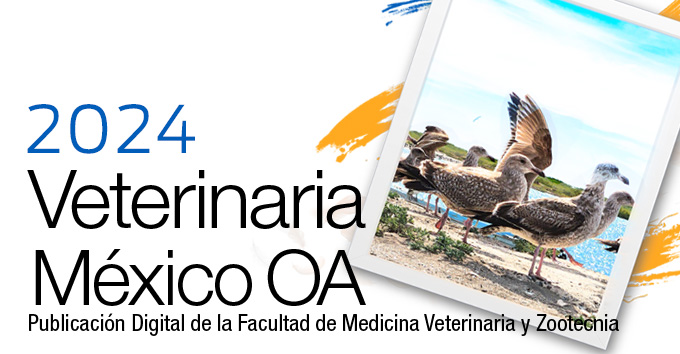Histophilosis in cattle: microbiology, epidemiology and pathology
Main Article Content
Abstract
Histophilosis is a group of diseases suffered by domestic and wild ruminants, produced by Histophilus somni (formerly Haemophilus somnus), a gram-negative bacterium considered an opportunistic pathogenic microorganism that lives in the mucous membranes of ruminants. It mainly affects the respiratory and reproductive tract, as well as the central nervous system; it is also associated with various generalized disorders such as myocarditis, polyarthritis, conjunctivitis, choroiditis, mastitis, epididymitis, otitis, and septicemia. The aim of this review is to provide updated information on this group of diseases affecting cattle, covering the characteristics of the etiological agent, its main virulence factors, epidemiological aspects, and the pathogenesis of the infection. Additionally, the distribution of the disease worldwide, its diagnosis, prevention, and control are included.
Article Details
References
Angen Ø, Ahrens P, Kuhnert P, Christensen H, Mutters R. Proposal of Histophilus somni gen. nov., sp. nov. for the three species incerta sedis Haemophilus somnus, Haemophilus agni” and Histophilus ovis. International Journal of Systematic and Evolutionary Microbiology. 2003;53(5):1449−1456. doi: 10.1099/ijs.0.02637-0.
Angen Ø, Ahrens P, Tegtmeier C. Development of a PCR test for identification of Haemophilus somnus in pure and mixed cultures. Veterinary Microbiology 1998;63:39−48. doi: 10.1016/S0378-1135(98)00222-3.
O’Toole D, Sondgeroth KS. Histophilosis as a natural disease. Current Topics in Microbiology and Immunology. 2016;396:15−48. doi: 10.1007/82_2015_5008.
Swati S, Pooja KPJ, Krithiga N, Juwar D, Manjunatha R, Sharan SP, et al. Respiratory infections in yak (Bos grunniens): a pilot study on isolation and direct PCR diagnosis for pasteurellosis, mannheimiosis and histophilosis. Indian Journal of Animal Sciences 2018;88(9):998−1002. doi: 10.56093/ijans.v88i9.83540.
Humphrey JD, Stephens LR. Haemophilus somnus: a review. Veterinary Bulletin. 1983;53:987−1004.
Inzana TJ, Corbeil LB. Development of a defined medium for Haemophilus somnus isolated from cattle. American Journal of Veterinary Research. 1987;48(3):366−369.
Canto GJ, Biberstein EL. Serological diversity in Haemophilus somnus. Journal Clinical Microbiology. 1982;15:1009−1015. doi: 10.1128/jcm.15.6.1009-1015.1982.
Angen Ø. Taxonomy of Histophilus somni. Current Topics in Microbiology and Immunology. 2016;396:1−14. doi: 10.1007/82_2015_5007.
Bandara BA, Zuo Z, McCutcheon K, Ramachandran S, Heflin RJ, Inzana TJ. Identification of Histophilus somni by a nanomaterial optical fiber biosensor assay. Journal Veterinary Diagnostic Investigation. 2018;30(6): 821−829. doi: 10.1177/1040638718803665.
Siddaramappa S. Histophilus somni genomics and genetics. Current Topics in Microbiology and Immunology. 2016;396:49−70. doi: 10.1007/82_2015_5009.
Inzana TJ. The many facets of lipooligosaccharide as a virulence factor for Histophilus somni. Current Topics in Microbiology and Immunology. 2016;396:131−148. doi: 10.1007/82_2015_5020.
Inzana TJ, Glindermann G, Cox AD, Wakarchuk W, Howard MD. Incorporation of N-acetylneuraminic acid into Haemophilus somnus lipoologosaccharide (LOS): enhancement of resistance to serum and reduction of LOS antibody binding. Infection and Immunity. 2002;70:4870−4879. doi: 10.1128/IAI.70.9.4870-4879.2002.
Behling-Kelly E, Rivera-Rivas J, Czuprynski CJ. Interactions of Histophilus somni with host cells. Current Topics in Microbiology and Immunology. 2016;396:71−87. doi: 10.1007/82_2015_5010.
Petruzzi B, Inzana TJ. Exopolysaccharide Production and biofilm formation by Histophilus somni. Current Topics in Microbiology and Immunology. 2016;396:149−160. doi: 10.1007/82_2015_5013.
Sandal I, Inzana TJ, Molinaro A, De Castro C, Shao JQ, Apicella MA, et al. Identification, structure, and characterization of an exopolysaccharide produced by Histophilus somni during biofilm formation. BioMed Central Microbiology. 2011;11:186−202. doi: 10.1186/1471-2180-11-186.
Sandal I, Shao JQ, Annadata S, Apicella MA, Boye M, Jensen TK, et al. Histophilus somni biofilm formation in cardiopulmonary tissue of the bovine host following respiratory challenge. Microbes and Infection. 2009;11(2):254−263. doi: 10.1016/j.micinf.2008.11.011.
Corbeil LB. Histophilus somni surface proteins. Current Topics in Microbiology and Immunology. 2016;396:89107. doi: 10.1007/82_2015_5011.
Gogolewski RP, Kania SA, Liggitt HD, Corbeil LB. Proctective ability of antibodies against 78 and 40 kilodalton outer membrane antigens of Haemophilus somnus strains. Infection and Immunity. 1988;56:2307−2316. doi: 10.1128/iai.56.9.2307-2316.1988.
Cengiz S, Adıgüzel M, Dinç G. Detection of Pasteurella multocida, Mannhemia haemolytica, Histophilus somni and Mycoplasma bovis in cattle lung. Revista Mexicana de Ciencias Pecuarias. 2021;12(3):710−720. doi: 10.22319/rmcp.v12i3.5469.
Stephens LR, Little PB, Wilkie N, Barnum DA. Infectious thromboembolic meningoencephalitis in cattle: a review. Journal of American Veterinary Medical Association. 1981;178:378−384.
Harris FW, Janzen ED. The Haemophilus somnus disease complex (haemophilosis): a review. Canadian Journal Veterinary Research. 1989;30:816−822.
Bano L, Bonci M, Drigo I, Tonon E, Mazzolini E, et al. Recurrent detection of Histophilus somni in the genital tract of dairy cattle with reproductive failures in Italy. Large Animal Review. 2011(17):171−176.
Margineda CA, O`Toole D, Prieto M, Uzal FA, Zielinski GC. Histophilus somni myocarditis and leptomeningitis in feedlot cattle: case report and occurrence in South America. Journal Veterinary Diagnostic Investigation. 2019;31(6):893−898. doi: 10.1177/1040638719876302.
Wessels J, Wessels ME, Thomson L. Histophilus somni myocarditis in cattle in the UK. Veterinary Record. 2004;154:608.
Headley AS, Carvalho BL, Fernandes AA, Elsen Saut JP, Lopes BA, Alcindo AA. Bovine respiratory disease associated with Histophilus somni and bovine respiratory syncytial virus in a beef cattle feedlot from Southeastern Brazil. Semina: Ciencias Agrárias Londrina. 2017;38(1):283−293. doi: 10.5433/1679-0359.2017v38n1p283.
Sharifzadeh A, Doosti A, Dehkordi PG. Frequency of Haemophilus somnus in the semen of bulls in Iran as determined by polymerase chain reaction. Scientific Research and Essays. 2011;6(6):1458−1460. doi: 10.5897/SRE11.205.
Goldspink LK, Mollinger JL, Barnes TS, Groves M, Mahony TJ, Gibson JS. Antimicrobial susceptibility of Histophilus somni isolated from clinically affected cattle in Australia. The Veterinary Journal. 2015;203(2):239−243. doi: 10.1016/j.tvjl.2014.12.008.
Aguilar RF, Trigo TFJ, Herrera LE, Avila GJ, Suárez GF. Histophilus somni (Haemophilus somnus) aislado en casos de problemas de tracto reproductor de ganado lechero. Primer reporte en México. Técnica Pecuaria en México. 2005;43(2):185−195.
Ortega-Pacheco A, Gutiérrez-Blanco E, M. Blanco-Molina J, Guillermo-Cordero J. An outbreak of bovine thromboembolic meningoencephalitis in Yucatan, Mexico. Veterinary Record. 2014;2(1). doi: 10.1136/vetreccr-2013-000034.
Kapustin AV, Moiseeva NV, Laishevtcev AI, Luchko MA, Histophilosis of cattle. Russian Journal of Agricultural and Socio-Economic Sciences. 2017;10(7):319−326. doi: 10.18551/rjoas.2017-10.45.
Chai J, Capik SF, Kegley B, Richeson JT, Powell JG, Zhao J Bovine respiratory microbiota of feedlot cattle and its association with disease. Veterinary Research. 2022;53(1):4. doi: 10.1186/s13567-021-01020-x.
Li C, Zaheer R, Kinnear A, Jelinski M, McAllister TA. Comparative microbiomes of the respiratory tract and joints of feedlot cattle mortalities. Microorganisms. 2022;10:134. doi: 10.3390/ microorganisms10010134.
Saunders JR, Thiessen WA, Janzen ED. Haemophilus somnus infections I. A ten years (1969−1978) retrospective study of losses in cattle herds in western Canada. The Canadian Veterinary Journal. 1980;21:119-123.
USDA. Feedlot 2011. Part IV: health and health management on US feedlots with a capacity of 1,000 or more head. NAHMS Feedlot Studies. US: Fort Collins: National Animal Health Monitoring System, USA. 2013.
Griffin D. The monster we don’t see: subclinical BRD in beef cattle. Animal Health Research Reviews. 2014;15(2):138−141. doi: 10.1017/S1466252314000255.
Humphrey JD, Little PB, Barnum DA, Doig PA, Stephens LR, Thorsen J. Occurrence of Haemophilus somnus in bovine semen and in the prepuce of bulls and steers. Canadian Journal of Comparative Medicine. 1982;46: 215−217.
Waldhalm DG, Hall RF, Meinershagen BS, Card CS, Frank FW. Haemophilus somnus infection in cow as a possible contributing factor to weak calf syndrome: isolation and animal inoculation studies. American Journal Veterinary Research. 1974;35:14011403.
Dobberstein R. Isolation of Histophilus somni and Truperella pyogenes from 2-month-old calf with chronic fibrosins and suppurative epididymitis. The Canadian Veterinary Journal. 2020;61:776−778. PMCID: PMC7313357.
Kwiecien JM, Little PB. Haemophilus somnus and reproductive disease in the cow: a review. The Canadian Veterinary Journal 1991;32:595−601. PMCID: PMC1481068.
Panciera RJ, Dahlgren RR, Rinker HB. Observations on septicemia of cattle caused by Haemophilus-like organism. Veterinary Pathology. 1968;5:212−226. doi: 10.1177/030098586800500303.
Thanthrige-Dona N, Lung O, Furukawa-Stofferb T, Buchananb C, Josephc T, Godsond DL, et al. A novel multiplex PCR-electronic microarray assay for rapid and simultaneous detection of bovine respiratory and enteric pathogens. Journal Virology Methods. 2018;261:51−62. doi: 10.1016/j.jviromet.2018.08.010.
Pansri P, Katholm J, Krogh KM, Aagaard AK, Schmidt LMB, Kudirkiene E, et al. Evaluation of novel multiplex qPCR assays for diagnosis of pathogens associated with the bovine respiratory disease complex. Veterinary Journal. 2020;256:105425 doi: 10.1016/j.tvjl.2020.105425.
Conrad CC, Daher RK, Stanford K, Amoako KK, Boissinot M, Bergeronn MG, et al. A sensitive and accurate Recombinase Polymerase Amplification Assay for detection of the primary bacterial pathogens causing Bovine Respiratory Disease. Frontiers in Veterinary Science. 2020;7:208. doi: 10.3389/fvets.2020.00208.
Mohan S, Pascual-Garrigos A, Brouwer H, Pillai D, Koziol J, Aaron Ault A, et al. Loop-mediated isothermal amplification for the detection of Pasteurella multocida, Mannheimia haemolytica, and Histophilus somni in bovine nasal samples. ACS Agricultural Science and Technology. 2021;1:100−108. doi: 10.1021/acsagscitech.0c00072.
Pascual Garrigos A, Maruthamuthu MK, Ault A, Davidson JL, Rudakov G, Pillai D, et al. On farm colorimetric detection of Pasteurella multocida, Mannheimia haemolytica, and Histophilus somni in crude bovine nasal samples. Veterinary Research. 2021;52:126. doi: 10.1186/s13567-021-00997-9.
Magstadt DR, Schuler AM, Coetzee JF, Krull AC, O’Connor AM, Cooper VL et al. Treatment history and antimicrobial susceptibility results for Mannheimia haemolytica, Pasteurella multocida, and Histophilus somni isolates from bovine respiratory disease. cases submitted to the Iowa State University Veterinary Diagnostic Laboratory from 2013 to 2015. Journal Veterinary Diagnostic Investigation. 2018;30(1):99−104. doi: 10.1177/1040638717737589
Stanford K, Zaheer R, Klima C, McAllister T, Peters D, Niu YD, et al. Antimicrobial resistance in members of the bacterial bovine respiratory disease complex isolated from lung tissue of cattle mortalities managed with or without the use of antimicrobials. Microorganisms. 2020;8(2):288. doi: 10.3390/microorganisms8020288.
Yatsentyuk SP, Pobolelova YI, Rudnyaev DA, Laishevchev AI, Kapustin AV. Identification of antibiotic resistance of the cattle pathogen Histophilus somni. Agricultural Biology. 2021;56(2):304−314. doi: 10.15389/agrobiology.2021.2.304eng.
Capik SF, Moberly HK, Larson RL. Systematic review of vaccine efficacy against Mannheimia haemolytica, Pasteurella multocida and Histophilus somni in North American cattle. Bovine Practitioner. 2021;55(2):125−133. doi: 10.21423/bovine-vol55no2p125-133.
License

Veterinaria México OA by Facultad de Medicina Veterinaria y Zootecnia - Universidad Nacional Autónoma de México is licensed under a Creative Commons Attribution 4.0 International Licence.
Based on a work at http://www.revistas.unam.mx
- All articles in Veterinaria México OA re published under the Creative Commons Attribution 4.0 Unported (CC-BY 4.0). With this license, authors retain copyright but allow any user to share, copy, distribute, transmit, adapt and make commercial use of the work, without needing to provide additional permission as long as appropriate attribution is made to the original author or source.
- By using this license, all Veterinaria México OAarticles meet or exceed all funder and institutional requirements for being considered Open Access.
- Authors cannot use copyrighted material within their article unless that material has also been made available under a similarly liberal license.



